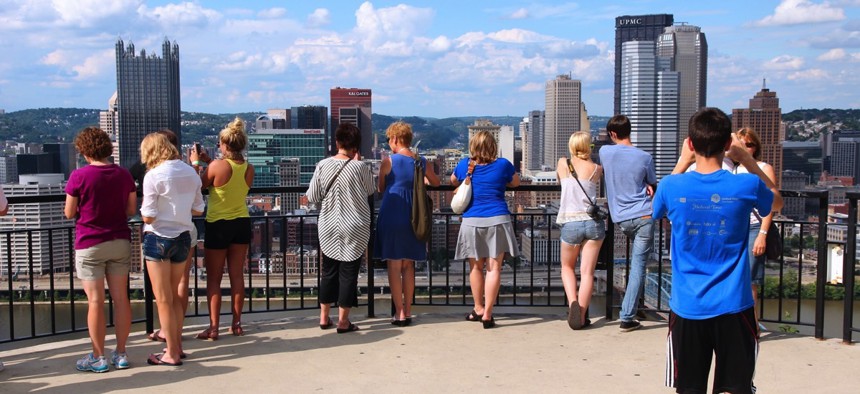Pittsburgh’s New Resilience Strategy Confronts Inequity, Infrastructure Stresses

Pittsburgh, Pennsylvania
The Western Pennsylvania city might not face severe weather shocks as often as others do, but residential segregation and deferred maintenance have left “Steel City” plenty to contend with.
The city of Pittsburgh on Wednesday revealed a new resilience strategy, ONEPGH , a plan that focuses on the interconnected short- and long-term challenges of inequity, public health, aging infrastructure and flash flooding.
The plan hinges on collaboration among the city’s 90 distinct neighborhoods, many of which are isolated by Pittsburgh’s challenging geographic divisions, including three major rivers and numerous hills and ridges.
Pittsburgh’s low cost of living masks the ongoing stresses of residential segregation and income disparities. As of 2011, white households in the city make an average of $15,371 more a year than African-American households, according to the U.S. Census Bureau.
“Pittsburghers are passionate about their city and their neighborhoods,” Grant Ervin, the city’s chief resilience officer, said in an announcement. “This connection, which goes beyond a physical space, will be one of the city’s greatest strengths as we coordinate, amplify and accelerate our existing resilience work as a member of the [100 Resilient Cities] global network.”
100 Resilient Cities, a Rockefeller Foundation initiative, included Pittsburgh into its second round of member cities in December 2014. ONEPGH was crafted with input from residents and the city’s private and nonprofit sectors and with commitments from 100RC platform partners like Manchester Bidwell Corporation, Fourth Economy Consulting and Intermedix/University of Pittsburgh Graduate School of Public Health.
Equal access to resources, inclusive land-use practices, sustainable infrastructure and reducing the Pittsburgh’s carbon footprint are all staples of the strategy:
The decentralization of assets and lack of capacity for service delivery at the city government led to the rise of philanthropy and the nonprofit sector to fill the voids and maintain quality of life for Pittsburghers. Today, as the City government rebounds, fragmentation between organizations and government challenges the efficiency of providing services to city residents, while years of deferred maintenance of the city’s oversized infrastructure is emerging from a major stress into a cascade of shocks.At the same time, however, rising housing prices in Pittsburgh’s traditionally mixed-income neighborhoods, concerns that the new tech-based economic growth may not provide broad-based opportunities, and a recognition that Pittsburgh’s close neighbors (its inner-ring suburbs) have largely not rebounded from the collapse of the steel industry have raised questions about who is benefiting from Pittsburgh’s transformation. Recent analyses ranked Pittsburgh in the bottom quarter of the top 100 regions nationwide in terms of progress on racial economic inclusion, as defined by racial gaps in wages, poverty, and employment.
The plan also acknowledges local venture capital investment won’t meet the needs of the city’s startup community, necessitating “thoughtful planning, close coordination, and integration between and among government and nongovernmental partners”.
Pittsburgh’s announcement comes on the heels of Tuesday’s unveiling of Zilient , a networking and knowledge-sharing platform for global resilience practitioners, by The Rockefeller Foundation.
“Networks are critical to the future of resilience,” Sam Carter, Rockefeller’s managing director, said in an announcement. “As The Rockefeller Foundation has seen first-hand with our 100 Resilient Cities network, when resilience practitioners are able to connect, converse and share with each other, we have unlimited capacity to advance this field.”
Dave Nyczepir is a News Editor at Government Executive’s Route Fifty and is based in Washington, D.C.
NEXT STORY: Fourth Annual ‘City on a Cloud’ Challenge Includes School Districts






